Banks raced out of the blocks in the first few months of 2023, maintaining last year’s pace of bond issuance. In the first half of this year, €131.4bn was issued in covered format, following the €207bn raised in 2022. Eurozone banks, in particular, made a rampant start as they sought to secure what remained of the ECB bid.
“Euro area issuers closely watched the ECB’s behaviour early this year, anticipating that it would reduce its primary purchases to zero,” says Joost Beaumont, head of bank research at ABN Amro in Amsterdam.
Rumours circulated in January that the ECB would wind down primary market purchases under the third Covered Bond Purchase Programme (CBPP3), first with a cut from 20% to 10% of a deal’s size. This, in part, helped to spur a rapid start, as eurozone banks issued just over €23bn.
Issuers rushed to secure the ECB’s bid, with a number of those that priced bonds late in January doing so with shortened settlement periods to make sure the bonds were issued before the start of February, the time from which the ECB’s order shrunk.
The much-heralded ECB cut duly arrived. It ceased primary market purchases altogether the following month.
Eurozone banks issued just under €23bn again in February but supply from the bloc fell sharply in March, to only €3bn. It was left to non-eurozone borrowers to pick up the slack and these banks contributed €16bn of supply in March, up from €3.75bn in February and €4.25bn in January.
“The end of QE led [eurozone] issuers to come to the market,” says Beaumont. “We saw issuers last year increase their deal sizes, in part for higher liquidity, but I suspect also to allow for a greater allocation to the ECB.”
On average, eurozone borrowers raised €827.5m in single tranches during the first half of the year, compared to €751.6m in 2022 and €639.2m in 2021, according to PMM and Dealogic data. The average size of their non-eurozone counterparts’ sales remained more stable at €1.08bn during the first half of 2023, compared to €1.06bn last year.
Average monthly covered vs senior new issue spreads YTD (bp)
Source: Primary Market Monitor/iTraxx
2023 H1 supply compared to H1 2022 and FY 2022 (in euros) — select jurisdictions
€m syndicated covered bonds
Source: Primary Market Monitor
For whom the TLTROs
Repayments under the ECB’s latest Targeted Longer-Term Refinancing Operations (TLTRO) end in December 2024, meanwhile UK banks will have to pay back their Term Funding Scheme with additional incentives for SMEs (TFSME) borrowing from the Bank of England over the coming years.
Many banks are choosing to finance these repayments by drawing down on their abundant liquidity coverage ratios. Liquidity levels swelled during the Coronavirus pandemic as a reams of cheap central bank liquidity and surplus deposits flowed into banks’ coffers.
Eurozone bank liquidity coverage ratios peaked at an average of 173.81% in the second quarter of 2021, according to ECB data. This has since fallen to 161.46% at the end of 2022 — but banks still have a way to go before they return to their pre-Covid levels of around 140%.
Although this liquidity will provide the bulk of TLTRO repayments, banks are also leaning again on the wholesale market — with an emphasis on covered bonds, their cheapest source of funding — to support this refinancing.
“An increase in issuance activity was expected, given funding schemes such as TLTRO and TFSME are now being refinanced,” says Peter Green, head of senior funding and covered bonds and debt investor relations at Lloyds Banking Group in London.
Beaumont agrees, saying: “Banks need to rely more on wholesale funding again [after the winddown of the TLTRO]. TLTRO repayments explain some of the large volumes as euro area banks rush to repay the quite substantial amount of loans they had outstanding.”
He adds that the step up in supply from Austria over the last 18 months — rising from €4.85bn in 2021 to €15bn in 2022 and €11.4bn in the first half of this year — is “is partly related to the TLTRO”.
In fact, the €11.4bn raised by Austrian banks in the first half of the year far exceeds the €1.75bn of redemptions expected throughout 2023.
Eurozone banks have just under €600bn of outstanding TLTRO loans — split across six tranches — they need to repay before the end of next year.
This need has driven an increase in funding from the eurozone periphery. Italian, Portuguese and Spanish supply this year, for instance, has already outstripped the total raised in 2022.
Italian firms placed €6.5bn in the first half of this year, close to double the €3.5bn raised in 2022. Meanwhile, Spanish banks issued €7.75bn in the first half, up from €5.75bn last year. No Portuguese banks tapped the market in 2022. The two Portuguese deals totalling €1.25bn from Banco Santander Totta and Banco BPI issued this year were the first from the country since July 2019, four months after the ECB launched its third TLTRO scheme.
The return of these eurozone periphery issuers “is clearly related to TLTRO repayments,” says Beaumont.
Month by month syndicated covered bond issuance in euros
€m
Source: Primary Market Monitor/Dealogic
Covered bond premiums make up a higher percentage of the overall spread
NIP as a percent of the overall spread to mid-swaps on euro bank bonds (%)
Source: Primary Market Monitor
Covered NIPs are optically smaller compared to unsecured bonds
Average monthly new issue premium for senior, bail-in senior and covered bonds priced over mid-swaps (bp)
Source: Primary Market Monitor
Investors in control
Issuers paid higher new issue concessions in early 2023 compared to the final months of 2022 as banks flocked to the covered bond market. As the ECB left the market, those investors which stepped in to fill the void demanded more spread to compensate.
“Because of the large volumes issued, the balance in the market has gradually shifted to the investors,” says Beaumont. “Banks could rely on the ECB bid for years, but now that’s gone they must rely on public investors again — and these investors can be quite selective.”
A new issue premium of 5.9bp was needed on average for the €27.6bn of paper placed in January, compared to the 5.1bp needed for the €18.6bn issued last November. On average banks had to offer 5.4bp of premium during the first half of the year.
Only one deal landed through its issuer’s outstanding curve, PMM data shows. DekaBank achieved this feat in January, pricing a €250m two year note at 11bp through mid-swaps, 1bp tighter than fair value. Demand for this deal peaked at €1.7bn.
Less popular or riskier deals needed larger concessions. For instance, Slovakia’s Slovenská Spořitelna had to offer a 15bp concession on its January visit. Raiffeisen Austria needed 11bp to secure €500m of long four year funding in May, off the back of a €700m book. Bankers away from the deal said the firm’s exposure to Russia and the high level of Austrian supply this year led to lower credit line availability among investors.
“From an investors’ perspective, issuers now must pay up,” says Beaumont. “Although the increase in premium is marginal, it shows the move towards an investor focussed market.”
However, although covered bonds require lower premiums compared to senior paper — often in the low single digits of basis points — their overall tight headline spreads mean that the concessions offered make up a far higher share of the overall cost. In June, new issue premiums made up 38.8% of the final spread needed for euro covered bonds, a far cry from the 12.5% needed for a senior preferred trade.
Despite having widened almost 20bp since the start of the year, the average monthly new issue spread to mid-swaps for a euro covered bond was only 41.95bp in July this year — a far cry from the 119.28bp and 169.75bp required for new senior preferred and non-preferred deals that same month.
“Investor appetite for the product is quite strong thanks to the rise in rates,” says Beaumont. “But at the same time, covered bonds are still the cheapest funding tool for banks. For banks facing rising funding costs, covered bonds are an attractive way to limit this rise.”
Green at Lloyds says: “Supply year to date seems to have been well received, with more traditional investors returning to the product.”
Banks raised €132.7bn in covered format during the first half of the year and are well on track to come close to — if not exceed — last year’s record. At the same point in 2022, banks had pushed €122.73bn through the market on their way to a record €206.95bn final total.







